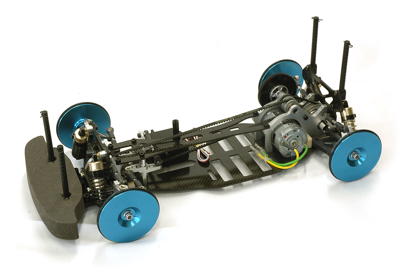
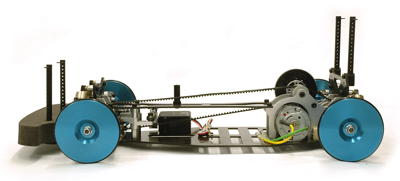
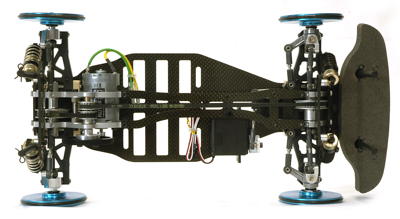 The
TRF 414X is a holy grail amongst Tamiya collectors and it's precise
history is difficult to trace because there are few references and very
little of the development was publicly shared. From the data I've
been able to gather, Tamiya America was interested in a high-end touring
car chassis that could be competitive in international racing, and
Tamiya Japan's Masayuki Miura volunteered to head a team (along with
Takanori Aoki and Takahiko Yasuito) to develop such a chassis in
1998. The result was a prototype called the TRF 404X. This
was never a commercial product and never available to purchase.
The chassis was raced and modified until it was mature enough to be
turned into a product, the 93013
TRF 414X in 1999. It did not even include a proper manual, but
instead used a stack of
loose papers showing exploded views of the major components. This
was only available in the USA to racers, and appears to have been
limited to 150 copies. Those copies were raced, modified, damaged,
and/or destroyed by their owners, so finding one today in any condition
is a near impossibility. As if that story wasn't convoluted
enough, Tamiya Japan released it's own version of the TRF 414X as a
"completed model" fully built in a hard case and signed by the
developers in 2000. This version does not appear to have any kind
of kit number and I wouldn't have had any way of knowing that it even
existed except that I found one. The version I was finally able to
acquire was never raced and came pristine in a box signed by the
developers. Score.
The
TRF 414X is a holy grail amongst Tamiya collectors and it's precise
history is difficult to trace because there are few references and very
little of the development was publicly shared. From the data I've
been able to gather, Tamiya America was interested in a high-end touring
car chassis that could be competitive in international racing, and
Tamiya Japan's Masayuki Miura volunteered to head a team (along with
Takanori Aoki and Takahiko Yasuito) to develop such a chassis in
1998. The result was a prototype called the TRF 404X. This
was never a commercial product and never available to purchase.
The chassis was raced and modified until it was mature enough to be
turned into a product, the 93013
TRF 414X in 1999. It did not even include a proper manual, but
instead used a stack of
loose papers showing exploded views of the major components. This
was only available in the USA to racers, and appears to have been
limited to 150 copies. Those copies were raced, modified, damaged,
and/or destroyed by their owners, so finding one today in any condition
is a near impossibility. As if that story wasn't convoluted
enough, Tamiya Japan released it's own version of the TRF 414X as a
"completed model" fully built in a hard case and signed by the
developers in 2000. This version does not appear to have any kind
of kit number and I wouldn't have had any way of knowing that it even
existed except that I found one. The version I was finally able to
acquire was never raced and came pristine in a box signed by the
developers. Score.The TRF 414X is a twin belt, 4WD, racing touring car chassis. The upper and lower chassis plates, shock towers, and outer suspension mounts are carbon fiber plate. The bulkheads, pulleys, uprights, hub carriers, knuckles, steering cranks, and shock bodies are all machined aluminum. There are virtually no molded plastic parts in the whole chassis. The few plastic parts in the suspension (the inner suspension mounts and suspension arms) are machined from plastic blocks. Only the bumper support and body posts are molded. The rear axle uses a ball differential and the front uses a one-way setup. There is an additional front one-way bearing in the center shaft. The motor is located just ahead of the rear axle making for a very short rear belt and a much longer front belt. There are no belt tension adjustments in the bulkheads and no intermediate tensioner. The axles have CVD universals. The camber is adjustable at all four corners via turnbuckles and the front toe is adjustable the same way. Rear toe and skid angle are fixed. There are two roll center options available by using different holes in the suspension mounts. There are many optional holes for attachment of the upper control arms and shocks. The pinion and spur gear are 64p, unusual for a Tamiya model. The chassis is configured to use racing saddle packs of sub-C cells strapped down with glass tape.
In general I pride myself on having no shelf queens in my collection and driving everything I build, but in this case there is no way this chassis is ever going to see asphalt. It needs to stay exactly as it is and eventually get passed down to future generations.
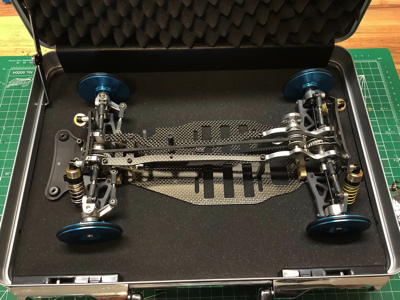 Page 1: Unboxing |
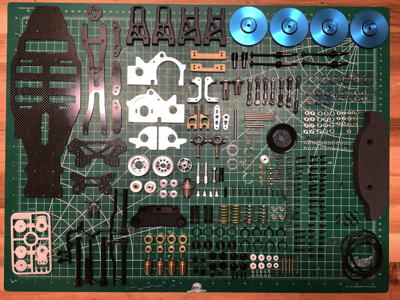 Page 2: Chassis Assembly |
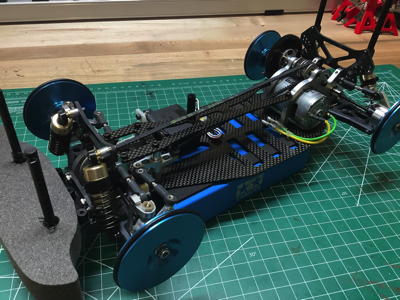 Page 3: Final Photos |